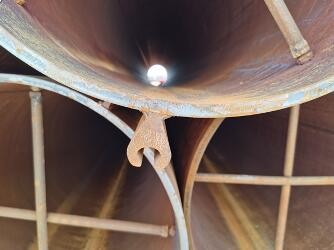
What is the difference between erw and the seamless pipe?
As the name suggests, pipes that are constructed without the use of a weld seam are known as seamless pipes. Whereas, welded pipes have the presence of a longitudinal weld seam on their surface. In addition to the method of construction, the pressure capacity, cost, and the application of each kind of pipe vary from the other.
The cost difference between seamless and erw pipes
Since seamless pipes have a longer manufacturing process, and the operations here are multiple, the cost of seamless pipes is always higher in comparison to a welded pipe. ERW pipes make use of cold formed sheets, which are then joined together by high frequency welding, which is a relatively simple process, with the cost being fractional in comparison to the seamless variety.
Why use seamless pipe instead of erw pipes?
There are two benefits of using a seamless pipe. First, the working pressure capacity of a seamless pipe is 20% higher than an erw pipe, because, unlike erw pipes, the application of a higher pressure level will not cause the pipe to fail or burst. And the other, more popular reason for choosing a seamless pipe is that they are not vulnerable to intergranular corrosion. As opposed to seamless pipes, the seam line on welded pipes, in particular, the HAZ or heat affected weld zone gets affected at the grain boundary due to sensitization. This fosters intergranular corrosion, thereby weakening the erw pipe.
Metal welding services
Why choose seamless pipe for Oil & Gas sectors?
The use of seamless pipes is suited to all operations that are high pressured. In the oil and gas industry, the flow of media through the system exerts a strong force on the pipes, especially, if the temperature is high. And this strong force coupled with the elevation in temperature creates a high level of stress on pipes. In the case of seamless pipes, their pressure bearing capacity is almost 20% higher, which makes them ideal for use in the oil and gas industry.
Seamless and erw pipe manufacturing process
Electric resistance welded, or as referred to in short as ERW pipe, may be produced by cold-forming a sheet of steel into the shape of a cylinder. After being cold formed, an electric current is then passed between the two edges of the steel. The electric current heats the cold formed steel sheet to a point such that the edges are forced synchronically to form a bond. The bond formed during this welding process is possible without the use of welding filler material. In order to achieve weld of the highest quality, a high frequency ERW process is considered to be the most commercially viable option.
Unlike welded pipes, the procedure to manufacture Seamless pipes is longer and more intensive. This process uses heat and several other operations to achieve the final product. Raw steel is first heated and cast into solid billets. These solid billets mold the raw steel alloy into the shape of a cylinder. Upon achieving the cylindrical shape, the raw steel pipe is then rolled until a stretched and hollowed product is created. This newly created product has a center that is irregularly shaped. To get a more even surface and uniform shaped hollow, a bullet-shaped piercer point is rammed through the center of the billet even as the billet is being rolled.
How to Identify Stainless Steel Seamless Pipe or ERW?
Pipes are produced using various specifications. However, if specification ASTM A53 is used in their construction, the pipes are marked via stencils. If the stencil print mentions Type S, the pipe has a seamless construction. On the other hand, if Type E has been stenciled onto the pipe, it indicates that the construction is an Electrical resist welded kind. Another method of confirming welded pipes is by the use of a UV examination. Under ultraviolet light, the grain structure of the pipe would show a distinct difference in the weld zone. Today, although there are surface treatments carried out to minimize the weld, it is possible to check for welds under UV examination.
